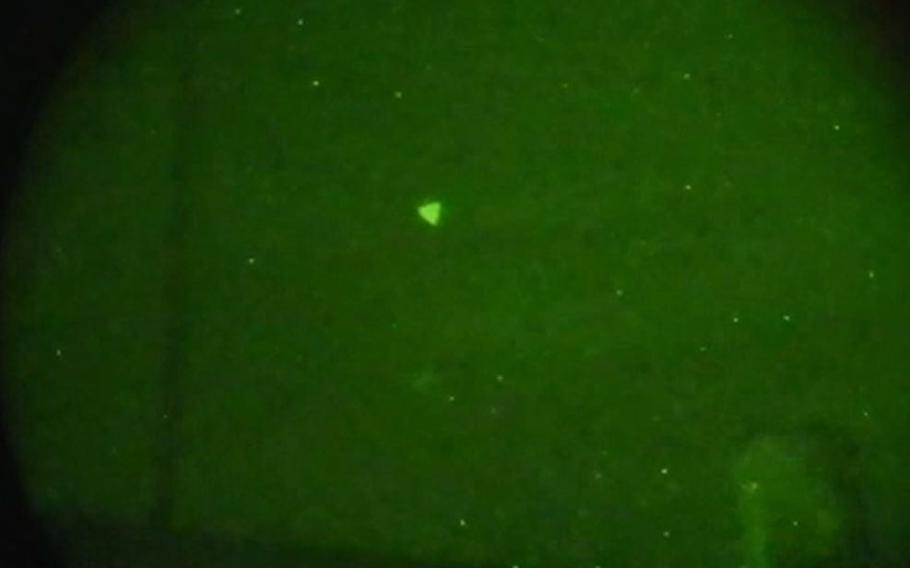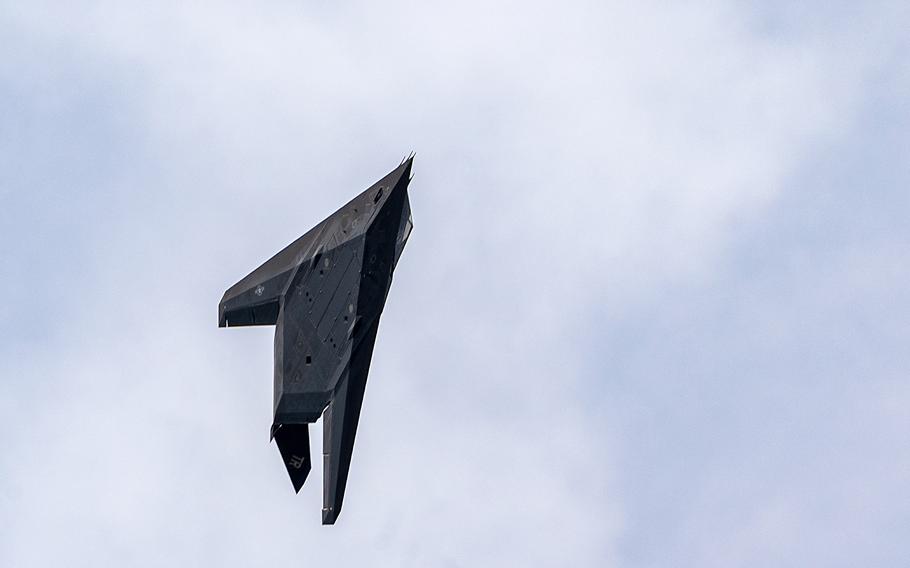
An unidentified object in the sky appears in a Navy image captured during a 2022 exercise off the east coast of the U.S. (U.S. Navy)
A lengthy Defense Department review of U.S. government activities related to “unidentified anomalous phenomena,” more commonly known as UFOs, has found no evidence that extraterrestrial intelligence has visited Earth or that authorities have recovered crashed alien spacecraft and are hiding them from the public.
The review, publicly released on Friday, covered all official U.S. investigatory efforts from 1945 to the present and examined classified and unclassified government archives.
It was unequivocal in its conclusions, finding “no evidence that any [U.S. government] investigation, academic-sponsored research, or official review panel has confirmed that any sighting of a UAP represented extraterrestrial technology.” Reports of flying objects or suspected alien craft usually turned out to have quotidian explanations: They were “ordinary objects and phenomena and the result of misidentification,” sometimes by well-meaning witnesses who thought they had spotted something otherworldly.
The report is likely to be scrutinized and rejected by independent investigators, former U.S. personnel and conspiracy theorists who appear convinced the government is hiding evidence of alien life and has constructed an elaborate set of classified programs devoted to reverse-engineering their technology. Last summer, a former intelligence officer who had served on a Pentagon UAP task force sparked headlines and speculation when he told Congress that the government has a secret repository of downed alien spacecraft and corpses.
The new report, compiled by the Defense Department’s All-domain Anomaly Resolution Office (AARO), directly addressed those allegations.
“AARO determined, based on all information provided to date, that claims involving specific people, known locations, technological tests, and documents allegedly involved in or related to the reverse-engineering of extraterrestrial technology, are inaccurate,” the office stated in a 60-plus page unclassified document.
Even before the report was published, critics of the office had questioned whether investigators would be hamstrung by a lack of access to highly classified material. But the office devised a “secure process,” according to the report, working with government agencies to review so-called special-access programs that interviewees had identified, either by their supposed code names or description.
The office’s investigators were “granted full access to all pertinent sensitive [U.S. government] programs,” and when companies and contractors were identified, the office interviewed senior-level executives, scientists and engineers in those organizations, the report stated. Investigators had access to a wide range of government departments and agencies, including the Defense Department and the military services, the intelligence community — including records held by the CIA — the Energy Department, the Homeland Security Department and the National Archives.
The investigators seemed to anticipate that their work would face a skeptical audience. They argued that the public’s imagination and misunderstanding about alien visitations has been fueled by an industry of TV shows, books, movies and social media that repeat the same extravagant claims about spaceships in hangars and alien bodies in basements.
“A consistent theme in popular culture involves a particularly persistent narrative that the [U.S. government] — or a secretive organization within it — recovered several off-world spacecraft and extraterrestrial biological remains … and that it has conspired since the 1940s to keep this effort hidden from the United States Congress and the American public,” the report stated.
Government personnel are some of the most ardent believers in that idea. The investigators interviewed about 30 people, including some who had worked on official UAP research programs, “who claimed to have insight into alleged [U.S. government] involvement in off-world technology exploitation,” the report said. In some cases, they had stumbled upon actual, highly classified programs that had nothing to do with aliens.
“Many have sincerely misinterpreted real events or mistaken sensitive U.S. programs for which they were not cleared as having been related to UAP or extraterrestrial exploitation,” Tim Phillips, the AARO acting director, told reporters.
Their conclusions were based on a sort of classified game of telephone, in which whispers of secret programs, often based on hearsay, circulated for years in the military and intelligence community.
“We saw a small group of people who knew each other, who all cited their observations as the purpose for their beliefs or for their observations,” Phillips said.
Some of those people had worked on UAP research under a Pentagon program in the early 2000s that aimed to study next-generation aerospace technologies. It had a powerful backer in then-Sen. Harry M. Reid (D-Nev.), who had an abiding interest in unidentified flying objects and hailed from the home state of Area 51, the secretive Air Force testing grounds that hold a central place in UFO lore. According to the report, UAP research was not part of the program’s mission, but it ventured into that territory, examining reports of paranormal activity, “creatures” and “international-dimensional phenomena.”
In 2017, the work of that outfit became public, along with videos taken from military aircraft that seemed to show UFOs flying at extraordinary speed, to the astonishment of military pilots. That exposure ushered in a new era of openness in the military and intelligence community, which began to examine UAPs — which some thought might be drones or hypersonic weapons — as a potential threat to national security and commercial aviation. Military personnel have since been encouraged to report sightings; some have later been attributed to foreign aircraft, surveillance balloons, atmospheric anomalies or simply debris floating in the air.
Confusion appeared to permeate the statements from witnesses who spoke to the AARO investigators. Some of the programs’ code names that interviewees provided turned out not to exist or could be traced back to defunct entities, the report found. One person mistakenly identified a private UAP research program as being run by the U.S. government.
Another program brought to AARO’s attention, Kona Blue, was alleged to be a Homeland Security Department effort “to cover up the retrieval and exploitation of ‘nonhuman biologics,’” the report found. In other words, alien bodies.
The origins of those suspicions, investigators found, traced back to some of those earlier Pentagon researchers, backed by Reid, who had strayed into studying UAPs.
When the Defense Intelligence Agency canceled that effort in 2012 “due to lack of merit,” its supporters proposed that Homeland Security fund a new version to investigate paranormal research, including “human consciousness anomalies,” the report found. The program, which they proposed calling Kona Blue, also would reverse-engineer “off-world spacecraft that they hoped to acquire.” The Kona Blue backers assumed that biological evidence of aliens was already in the government’s possession, the report found.
Homeland Security leaders ultimately rejected the proposal.
The AARO investigators investigated a number of specific claims, including that the CIA had been working with a company to examine alien spacecraft; that a former senior U.S. military officer had “touched the surface” of a spacecraft and had seen one “floating in a building,” presumably a military or contractor facility; and that alien technology remains in the possession of companies, not the government, as part of an effort to keep it away from congressional overseers.
Other interviewees provided accounts of their own UAP sightings, as well as claims that they had seen military personnel loading containers of spacecraft onto planes or overheard scientists discussing the presence of alien beings during the testing of specialized materials. Others claimed that people who knew about the classified activities had signed nondisclosure agreements with a provision that any breach of secrecy was “punishable by death.”
The AARO investigators found no evidence to substantiate these accounts and were able to dispute or debunk some of them.

A U.S. Air Force F-117 Nighthawk lands at Joint Base Elmendorf-Richardson, Alaska during Northern Edge 23-1, May 10, 2023. (Sheila deVera/U.S. Air Force)
The former military officer who was said to have touched a spacecraft denied this claim when investigators asked him about it, couldn’t remember the conversation in question and speculated that the issue might stem from a misunderstanding: He had, in fact, once touched an F-117 Nighthawk stealth fighter, “an aircraft so secret Nevada folklore labeled it a UFO,” according to an Air Force publication from 2018.
The person who claimed that aliens were present during a materials test had likely misunderstood the conversation, which probably referred to “a test and evaluation unit that had a nickname with ‘alien’ connotations at the specific installation mentioned,” the report said.
In another instance, an interviewee who claimed to have a seen an object “exhibiting strange characteristics” was probably correct. Based on the specific information provided, the person had likely witnessed the test of a new military “platform” that was “not related in any way to the exploitation of off-world technology,” the report found.
The AARO investigators even managed to get their hands on what private investigators alleged was a sample from an alien craft. On further inspection, it turned out to be a “manufactured, terrestrial alloy and does not represent off-world technology or possess any exceptional qualities,” the report found. The sample’s contents were magnesium, zinc and bismuth, with other trace elements such as lead.
People alleged to have participated in efforts to conceal alien technology, including executives at companies said to be participating in the classified work, denied this when questioned by investigators, attesting to the truthfulness of their statements for the record.
The Washington Post has previously interviewed six individuals who claimed to have information about U.S. government and private-sector crash retrieval and reverse-engineering activities. While the AARO report does not identify the people its investigators interviewed, several of their accounts match the detailed claims of those who spoke to The Post.
The Post chose not to publish these accounts because the individuals provided no evidence to corroborate their claims. Their information was almost exclusively based on second- or third-hand statements, usually from people the interviewees declined to identify. In some instances, congressional investigators who had interviewed the individuals believed they had probably mistaken actual classified programs for those related to UAPs and had reached conclusions about U.S. government activity that weren’t supported by direct evidence.